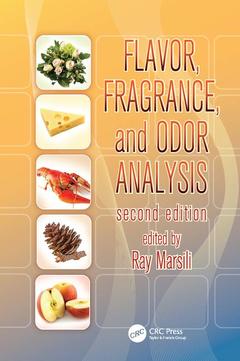Description
Flavor, Fragrance, and Odor Analysis (2nd Ed.)
Language: English
Subjects for Flavor, Fragrance, and Odor Analysis:
Keywords
Stir Bar Sorptive Extraction; Da Nc; gas; Log Kow; mass; Character Impact Compounds; spectrometry; Odor Compounds; thermal; Programmable Temperature Vapor Inlet; desorption; Sample Preparation; aroma; Tic; compound; Py Raz Ine; spectrum; UHT Milk; stir; Juniper Berry; bar; Stir Bar; Juniper Berry Oils; Strecker Aldehydes; Gas Chromatography Mass Spectrometry; Standard Addition Calibration Method; Yr Az; Standard Addition Calibration Curve; Van Aardt; Ethyl Octanoate; Ta Te; Peak Area Ratio; BA SE; Essential Oils; Cheddar Cheese
Publication date: 10-2016
· 15.6x23.4 cm · Paperback
Publication date: 01-2012
268 p. · 15.6x23.4 cm · Hardback
Description
/li>Contents
/li>Readership
/li>Biography
/li>
There are many advantages to stir bar sorptive extraction (SBSE) for isolating and concentrating flavor-active chemicals from foods, including its simplicity and wide application appeal. Written from a practical, problem-solving perspective, the second edition of Flavor, Fragrance, and Odor Analysis highlights this powerful technique and emphasizes the range of applications available.
Topics discussed include
- Sequential SBSE, a novel extraction procedure
- A simplified method for switching from one-dimensional to two-dimensional GC-MS
- How analytical sensitivity and recovery of phenolic compounds can be improved using aqueous acylation prior to SBSE GC-MS
- Analyzing and combating off-flavors caused by metabolites from microorganisms
- A technique for measuring synergy effects between odorants
- The identification of the characterizing aroma-active compounds of tropical fruits with high economic potential
- The parameters utilized during the production of aqueous formulations rich in pyrazines
- How spectral deconvolution can be used to speciate the subtle differences in essential oil content and track key ingredients through the manufacturing process
The final chapter summarizes chemical identities of characterizing aroma chemicals in fruits, vegetables, nuts, herbs and spices, and savory and dairy flavors. It also provides a brief compendium of the characterization of off-flavors and taints that are reported in foods.
With contributions from a distinguished panel of international experts, this volume provides chemists and researchers with the latest techniques for analyzing and enhancing food flavor and fragrance.
General applications. Techniques to maximize analyte sensitivity. Techniques to maximize GC peak resolution and MS identification. New GC-olfactometry approaches for studying synergistic effects of odor active compounds in food and beverage samples. Reference chapters describing formation of odor active chemicals in food systems.
Ray Marsili has published over 30 papers on food and flavor chemistry in refereed chemistry journals, as well as over 100 technical papers for trade publications and numerous chapters for flavor chemistry and dairy chemistry books. He served as a contributing editor of Food Product Design magazine, editor of R&D magazine's Sample Preparation Newsletter, and lecturer in organic chemistry at Rock Valley College, Rockford, Illinois. He has edited two previous books on flavor and odor analysis: Techniques for Analyzing Food Aroma (1997) and Flavor, Fragrance and Odor Analysis (2002). He has over 30-years' experience as an R&D analytical laboratory manager/flavor chemist for major national and international food and ingredient companies. Today, he is an independent analytical flavor consultant, with a laboratory at Rockford College, Rockford.




